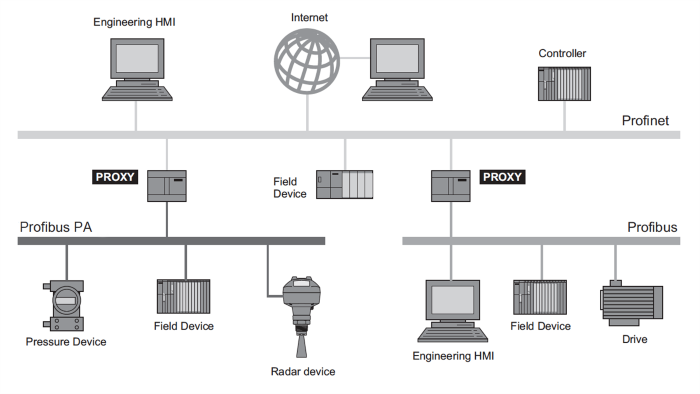When it comes to transmitting process variables, 4-20 mA is by far the most popular method. Digital fieldbuses such as PROFIBUS, PROFINET, or Foundation Fieldbus,  however, are said to be more accurate and generally better than 4-20 mA. What isn’t discussed very often, however, is the extent of how much more accurate they are. This topic is the elephant in the control room.
however, are said to be more accurate and generally better than 4-20 mA. What isn’t discussed very often, however, is the extent of how much more accurate they are. This topic is the elephant in the control room.
Although it’s generally accepted that the validity of a signal degrades with 4-20 mA, many individuals disregard that fact, or at least fail to recognize the extent of the degradation. That means that the elephant in the room that everyone is ignoring is huge!
Introduction
The 4-20 mA technology dates back to the 1950s. It has a number of beneficial properties:
- Easy to use
- Not subject to line losses like voltage signals
- Low cost
- Resistant to electrical noise
When it was released, it was revolutionary and almost totally replaced pneumatics.
However, it is 1950s technology and it has its limits and pitfalls. Most users work around some of these on a daily basis. And there are other issues that some users simply ignore. Accuracy is one of these.
All field devices today use digital technology. This means that 4-20 mA devices must convert the internal digital value into an analog value to transmit it, and then convert it back to digital at the controller. As is documented below, accuracy can be lost during the conversions as well as during the transmission.
Total possible error = measurement error + transmit error + transmission error + receive error
The transmit error
This error occurs when converting the digital value into 4-20 mA, and depends very much on the design of the instrument. At first, the stated accuracy of ±0.02 mA (Note 1) sounds small enough to be almost insignificant. But when calculated for a level transmitter and a 20 meter range, it translates into a maximum error of ±25 millimeters.
Here is how this calculation is derived: 0.02 mA / (20 mA – 4 mA) = 0.00125. When this value is multiplied by the full range of the instrument (20 meters), the result is 0.00125 X 20 = 0.025 meters, which is 25 millimeters.
The transmission error
The transmission error occurs during the transmission of the signal. It is very hard to determine since it is very dependent on the wire used and the amount of induced noise on the line.
The longer the run and the greater the electrical noise, the more effect the transmission will have on the overall error. Since this is so installation-dependent, we will ignore it for this discussion. However, the end user should not forget about it, because it can cause errors. Also, since it can vary over time, it may be hard to discern.
One situation that makes this worse is the use of variable frequency drives (VFDs). VFDs did not exist back in the 1950s when 4-20 mA was developed and they are well known for generating a lot of electrical noise.
If the devices are on all the time, then the noise is constant and can be ‘tuned out’ of the 4-20 mA loop. However, if the motors are turned on and off, the noise floor will move up and down and will not be able to be tuned out easily.
The receive error
When the 4-20 mA signal is converted back to digital after transmission, a receive error can occur, depending on the input card used. For example, with a 10-bit 4-20 mA input card, the receive error is ±20 millimeters on a 20-meter range.
Here is how the calculation is derived: 0 bits gives 2^10 values =1024. The range is 20 meters, so each division is
20 / 1024 = 0.0195 meters, which is 20 millimeters. Therefore, missing one division results in the ±20 millimeter measurement error.
Total possible error
As the formula above shows, the total possible error will be: measurement error + transmit error + transmission error + receive error. We know the measurement error is five millimeters. Therefore, the total error here is 5 + 25 + ? + 20 = 50 millimeters. This is ten times the measurement error!
Tuning the loop
Tuning the loop can help this, but there can be drift over time. Thus, the loop must be re-tuned regularly, which becomes a long-term maintenance issue and cost. Also, some of the unknown transmission error could be variable during the day. As mentioned above, the prime example of this is the use of VFDs. This noise cannot be tuned out.
A real-world processing plant
From the example, we see that attaching a five-millimeter accurate field device to a 10-bit 4-20 mA input card increases the error by up to ten times!
What happens if an instrumentation technician either does not put the cover back on the instrument or does not tighten the lid, or if the installation has a seal problem? As anyone who has worked in the industry knows, this is not uncommon. The result is water ingress.
How does water ingress affect 4-20 mA?
Clean water has little effect. Unfortunately, the rain water that gets into the instrument is either not clean or at least will not stay clean.
We performed an interesting experiment by taking some rain water that had been sitting in a wheelbarrow for a few weeks and pouring it into a 4-20 mA device while it was measuring level. (Note 2)
It was measuring 16.23 mA before the water was added. It quickly went up to 18.55 mA after adding the water. That is an 18.55 – 16.23 / 16 * 100 = 14.5 percent increase in value. If that was on the 20 meter example above, it would translate into 2.9 meter error!
How would one ever know? If it was a hot summer, the water would dry up and the value would go back down. At the next rain, the value would change again. The amount of rust and chemicals in the water would also have an effect. The process variable would have wide fluctuations in accuracy, affecting the process – and there would be little chance of ever catching it. (Note 3)
When we tried the same experiment with a PROFIBUS PA device, the water had no visible effect on the process variable or on the network. Considerable time (about one year) must pass before it would have a measurable effect on the network.
This can also be seen with PROFIBUS devices (Note 4) in the field. With a little bit of water over time, the waveform was far from ideal, but the network functioned and there was no loss of accuracy. When there was a lot of water, there quite a negative impact on the network. Although the PVs were, for the most part, transmitted, the error rate was high. However, there was no loss of accuracy. Thus, in summary, water can bring down the network, but it never silently removes accuracy from the process. If any sort of monitoring device is used, it will detect the problem.
What about scaling?
Related to the accuracy issue is the scaling issue. 4-20 mA instruments have to be scaled in at least two places (instrument and PLC) and often in HMI as well. This presents an opportunity for error. In this case, a major error will probably be detected, but a minor one may slip through the human verification process. In addition, the scaling and the verification take time to perform.
In the fieldbus world, this is not required – the instruments only need to be scaled once in the field device and the value is transmitted onward.
And what about space?
Cabinets are expensive. The bigger the cabinet, the more expensive it is. In this case, 4-20 mA is an elephant in terms of space. It requires a lot of wires and cabinet space. Fieldbuses take up much less space and have fewer wires, saving on both capital costs and wiring costs.
Conclusion
4-20 mA technology is the elephant in the control room for several reasons:
- It can increase measurement error by a factor of up to ten
- It requires loop calibration to help reduce the above error
- It was never designed to live with VFD noise
- Its accuracy is affected by water
- It needs to be scaled up in three places, which can lead to errors
- It requires significantly more cabinet space and wires
The problems and pitfalls of 4-20 mA are rarely discussed. Most people ignore the loss of accuracy, saying, “Oh, it can’t be that much!” But, as we have seen, it is! Some people believe that water ingress does not affect 4-20 mA because, after all, it still works. As we have seen, it does keep on working but with ridiculously high error rates.
To benefit from the accuracy of the instrument, a fieldbus such as PROFIBUS or PROFINET must be used. Good old 4-20 mA is really not so good after all. There is a better way:
 James Powell, Senior Product Specialist, Industrial Communications, Siemens
James Powell, Senior Product Specialist, Industrial Communications, Siemens
Author of Catching the Process Fieldbus: An Introduction to Profibus and Profinet. Available as a free download here.
Notes
1 This value was taken from the SITRANS LR250 manual. However, it is typical for other 4-20 mA instruments.
2 The idea for this experiment was borrowed from Russ Muller, PlantWeb specialist, Emerson Process Control.
3 If should be noted that this problem can be avoided by proper installation techniques and putting the lids on correctly.
4 See “Troubleshooting PROFIBUS PA – A practical example,” U.K. PROFIBUS & PROFINET User Conference, June 2008, or Chapter 9 of Catching the Process Fieldbus by James Powell.

